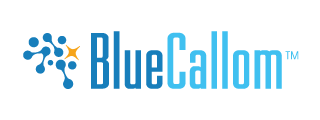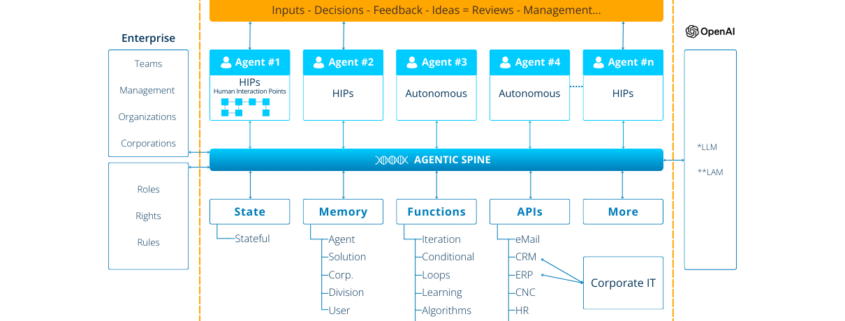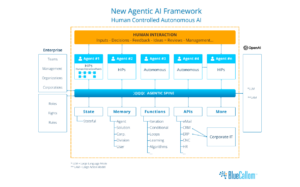New Agentic-AI Framework
Agentic AI for Corporate Use
AgenticBlue is BlueCalloms Agentic AI Framework for business use cases and enterprise-grade requirements. It allows solution developers or IT departments to build highly complex yet easy-to-design Agentic-AI solutions. Here is what we are going to discuss in this post. (Sorry, much longer than usual)
- The Nature of Agentic AI.
- What an agent can and a prompt cannot do.
- History of this Agentic-AI Framework.
- What ‘Prompt-over-Code’ means, and why it’s important.
- What is a Multi-Agent Design?
- What are Multi-Agent Protocols?
- What is an Agentic Design Method?
- Three Enterprise-Level Use Cases – showing what’s possible today
1. The Nature of Agentic AI Solutions
Most of you may already know – just to be on the same page:
- Allows you to build intelligent business solutions that may replace conventional software within the next 5-10 years.
- The user interaction model moves from data entry (input) and data visualization (output) to intelligent task delegation (input) and receives completed work in the form of reports, interaction with others, machine control, and more (output).
- Handle extremely complex situations beyond the capability of the human brain.
- Handles repetitive and often dull work.
- Can increase productivity and employee satisfaction by 20+%.
2. What can an agent do that a prompt cannot?
- Managing far more complex tasks – a single prompt can handle only one.
- Access to its environment like APIs, Data Models, sensors, Email Servers…
- Autonomous processing capabilities
- Using custom functions that can be individually coded if needed
- Memory management to remember previous results
- Autonomous planning and organizing
- Ability to communicate and collaborate with other agents
- Learning mechanisms
- Non-linear process management capability
- Universal agent-to-agent protocol for third-party agents
3. A Short History of Our Agentic-AI Framework
In early 2023, we created our first “Multi-Functional Prompts.” Those prompts had additional functionalities like sending emails, setting up custom models and retrieving their data, putting the results in PDF format, and more. Our “Conditional Prompts” and “Iterative Prompts” were our crown jewels back then. We also created an Innovation Management system with 124 of those multi-functional prompts – which we call Agents today. That solution was probably one of the most extended prompt chains. We called those prompts BluePrompts because they could not be run on ChatGPT, although we were using Open AI as our platform of choice. In 2024, we explored several ways to build more advanced agents than the BluePrompt Design. We were considering other platforms or open-source tools to code agents, particularly multi-agent systems, capable of dealing with enterprise solutions like our Innovation System. MOre importantly, we realized it’s time for an Agentic-AI Framework for corporate requirements.
AgenticBlue Framework, Technology & Methodology
The key aspects of this framework include:
- Employee involvement across an enterprise (Teams, Managers, Organizations, The entire corporation)
- A system that manages Rules, Rights, and Roles
- The top-down approach with humans in charge
- Numerous agents could be networked to an entire ERP system. Some are autonomous, and others have human interaction points.
- An agentic spine that orchestrates any type of agent connection, human interaction, and interaction with the system’s environment through functions and APIs
- The web is a stateless technology, but we need to have a stateful architecture to manage processes and time
- Memory has a new dimension. Conventional software stores data- whatever it has- and stores actions as logs. However, like humans, AI needs memory to keep track of entire thoughts, deal with process variables, and come back to relationships between things and processes at a later stage. A chain-0f-thoughts needs memory, but it can be forgotten after a certain time. All of this, within an enterprise with thousands of active users, has a very different meaning relative to a single person running an agent.
The functionality in more details
Human interactions are essential, even in autonomous agents—if only for oversight. The initial agent typically includes a Human Interaction Point (HIP). At this stage, someone must instruct the solution on its tasks, the manner of execution, the individuals interacting with it, and those managing the process. However, in practice, most agents operate autonomously, focusing on the tasks they perform best. Same here.
Unlike conventional software, which follows linear, step-by-step processes, the AgenticBlue Framework enables non-linear and parallel operations. Traditional software relies heavily on conditional logic but struggles with true parallelism. Our framework changes that by introducing a new orchestration model for managing lateral actions.
Inspired by the human nervous system, we developed a mechanism called the Agentic Spin. This system functions as a central communication strand, allowing agents to coordinate in parallel and manage complex workflows efficiently. The Agentic Spin is critical for agent-to-agent communication, ensuring seamless interactions across a vast network of agents when necessary.
Additionally, the framework supports agents with various functions and API integrations, maintaining a stateful environment and managing memory for different scopes. Instead of following the common advice to develop agents in Python—which would have resulted in massive code structures for enterprise solutions—we chose a different path. We prioritized Prompts as the leading instrument for all interactions over traditional coding. This approach isn’t just about simplicity; it offers superior scalability and leverages intelligence at every stage of the solution-building process. The ‘Prompt-over-Code’ model was born.
4. What is Prompt-over-Code
Designing non-linear processes—such as innovation, transformation, or complex banking solutions—is inherently difficult with traditional coding approaches. Managing complexity requires coordination, adaptability, and teamwork, which can make it challenging to involve external partners in projects. To address these issues, we made a conscious decision to move away from traditional coding in favor of a new paradigm: Prompt-over-Code.
Prompt-over-Code should not be confused with No-Code platforms. It represents a core design principle that leverages prompts and large language models (LLMs) to drive intelligent workflows. Instead of relying solely on rigid code structures, we use prompts to manage processes and call specific functions only when needed. These functions may include algorithms, deep learning mechanisms, API access, or natural language processing tasks. This approach allows us to build workflows that are dynamic and adaptable.
Prompt-Based Agent

Each agent consists of several prompts, which have access to a multitude of functions.
The BluePrompts system is designed with a sophisticated plug-and-play connection mechanism. This flexibility enables users to easily swap prompts, remove them, or add new prompts to the chain without disrupting the overall workflow. Non-linear and parallel processes are handled at the agent level, ensuring efficient task execution.
Each prompt can access custom models, initiate function calls, and execute iteration or loop functions as needed. Additionally, prompts can be designated as Human Interaction Points (HIPs) or set to function autonomously. In essence, we have shifted from writing extensive code to using prompts as the primary logic drivers, pulling in code only when necessary through function calls. This allows for greater flexibility, scalability, and the integration of intelligence at every step of the workflow.
TESTING
It is far easier to test individual prompts rather than code sequences.
Prompt stepper tests are easy to create and are part of every prompt.READABILITY
Prompts are easy to read and even more straightforward to comprehendMAINTENANCE
Prompt maintenance is fast and easy to handleCUSTOMIZATION
Prompts are much faster customized than codeADAPTABILITY
Well-written prompts don’t need to adapt to new knowledge – that is done by LLMsDEVELOPER MINDSET
Writing prompts is not just about how a task is completed but, more importantly, how intelligence is accessed. This was our main reason for going with an intelligence-focused development strategy rather than a code-focused, narrow-structured programming strategy.
Drag-and-Drop Prompt Integration
With our system, integrating prompts into agents is remarkably simple. Using an intuitive drag-and-drop mechanism, you can effortlessly arrange prompts within an agent, one after the other. To date, we have not encountered any limitations on the number of prompts an agent can accommodate. On average, we utilize anywhere from 3 to 20 prompts per agent, depending on the complexity of the task. Prompts can be easily selected from a predefined list and moved directly into the agent structure.
5. What is a Multi-Agent Design?
Creating a single agent results in a sophisticated and valuable AI tool. However, on its own, a single agent is just one functional component—far from a comprehensive strategic solution for your enterprise. To achieve true organizational impact, a Multi-Agent Design is essential.
Imagine building a complete enterprise solution comprised of 50 or more highly advanced agents, all interacting seamlessly. These agents would be orchestrated by a robust layer that manages non-linear processes, facilitates learning between agents, and coordinates workflows. Attempting to build such a system through traditional coding methods would be impractical—even with AI assistance. The complexity would surpass human comprehension, and coordinating development efforts would require entirely new paradigms for teamwork.
Multi-Agent Design and Protocol

Similar to how brain cells connect through neural pathways, agents in a Multi-Agent Design are linked via an intelligent connection mechanism. This allows them to communicate, collaborate, and adapt dynamically.
The Prompt-over-Code approach significantly reduces development overhead, enabling the creation of multi-agent environments that handle large, complex tasks with ease. Cross-functional solutions—spanning departments like sales, marketing, finance, and more—can now be effortlessly networked. The resulting intelligence within such networks unlocks unprecedented capabilities.
Consider a dynamic, real-time budget control system where revenue and profitability directly influence marketing spend allowances. Or imagine a product development process driven by real-time market data, with predictive models integrated across sales and marketing teams to assess opportunities and market viability. These types of cross-functional solutions were previously too complex and costly to implement with traditional tools, costing industries billions annually. Now, with a Multi-Agent Design, these solutions are within reach.
Additionally, agent authors benefit from several new features that can be quickly implemented, enhancing the flexibility and scalability of the system.
Also, we gained several new features that an agent author can quickly implement.
NON-LINEAR PROCESSES
An agent can trigger one or multiple other agents at any time. This comes in very handy for validation, review processes that look back, and look ahead processes, which can all be run while the core process does its job.PARALLEL PROCESSES
An agent can trigger multiple parallel processes. For instance, you have 100 situations to assess. Instead of looping one after the other, you branch out, let all 100 assess simultaneously, and make a summary once all are completed.DEAD-END PROCESS FEATURES
Also, you may want to farm out calculations that take longer or may not be relevant when the process is completed. You branch them out and let them complete the main process independently.
6. What is the Multi-Agent Protocol
We developed this Multi-Agent Protocol with scale in mind. Here are the requirements:
- Any agent should be able to communicate with any other agent.
- An agent needs to transfer data or a pointer to data to another agent.
- An agent shall be able to give instructions to another agent.
- An agent needs to exchange its characteristics with connected agents
- Pro- and Post-Synaptic connection mechanism that ensures compatibility between agents
- Agents and functions shall be connected through an agentic spine for fast processing
- An agent shall be able to read memory from the solution scope from any other agent.
- A solution owner shall be free to add third-party agents to their solution.
- The Multi-Agent Protocol shall be based on a ‘common creative’ license for free agent exchange.
- The Multi-Agent Protocol shall be enterprise-aware in handling the rules and rights of divisions and users.
Drag & Drop for Agent Integration
Like prompts, agents are entered into an AI Business Solutions per drag-and-drop. The only fixed position is the lead agent that starts a solution or project. Solutions with a defined ending have a fixed position tail agent to complete the project. Currently, there is no limit to how many agents fit a solution. We typically use 5 to 50 agents per solution. When composing a solution, you drag them from a list of agents into the AI solution.
All solution-ready Agents have a standardized universal connector between agents. That connector connects agents to exchange data, instructions, characteristics, and more.
7. What is the Agentic Design Method
The nine most essential steps to design a multi-agent solution. It assumes the existence of the above components of the Agentic AI Framework.
1) Purpose & Usecase definition
Define the purpose of the solution you want to build and give it a use case. With that, the AI will understand the bigger picture of what you want to achieve.
2) Goal Definition
Define the expected outcome. You can make it a relatively narrow goal or leave it open and let the AI surprise you with its own knowledge, experience, and thoughts.
3) Personas and players
Define the primary persona the AI should assume. Also, invite the players you want to be part of the project. The players may be employees, business partners, customers, or anybody else you want to involve.
4) Instructions / Assessments and reasoning
Provide initial instructions or ask for an initial situation assessment. Request a reason for the response. This may result in a first impression of the AI that a human interaction point may allow to review and possibly adjust
5) Solution development and reasoning
Now, provide instructions to develop a process, plan, or solution for problems.
The more details you provide about how it should be done, the more you restrict it. The more you provide framing information but let it create its own version of a result, the more likely it will be successful and less stressful for you.
6) BluePrince development
Require the AI to create a detailed blueprint of the process, plan, or solution so others can follow it. The others may be humans or machines. A blueprint may also be an instruction to build the respective agents for a solution.
7) Results, report development and human reasoning
Get a summary of the work, maybe resource or budget plans. Also, ask for detailed management reports, charts, and graphics for executive decisions. Explain why the reports are essential.
8) Human Review and decisions with human reasoning
Review the process with the AI. Let it know what was good, what was ok, what needs improvement, and why. This process can also be added after every step.
9) Learning
Ensure feedback, ratings, and rewards are planned throughout the processes. This aspect is usually done early before the actual building process. Rewards modeling is a great way to make the system learn from other feedback.
8. Use Cases, what’s possible today
The examples below are all Agentic AI native solutions. No conventional software but all sheer ‘artificial intelligence’ and human brainpower. All are multi-agent solutions that are usually used by multiple teams. However, they can be run fully autonomously. Like everything in AI we are far from really ready. But so is Microsoft Word after almost 40 years when still not getting a page format under control. All three solutions were built within one year. We are planning ten more to come this year.
1) Autonomous Innovation
A previous Innovation Management System (IMS) has been redesigned from the original 124 prompts to a 50-agent Multi-Agent Solution. With over 20 optional Human Interaction Points, the solution can be run 100% autonomously or with comprehensive human interactions. The entire innovation process includes
1) Initial innovation opportunity discovery, to not blindly hunt down some random ideas
2) The Ideation system, which results in breakthrough innovation based on the global knowledge of AI
3) Roadmap development solution
4) The Concept validation system possibly involving customers and business partners
5) A financial planning and validation system for the CFO
6) Solution BluePrint Designer that explains every part that needs to be created
7) Solution building solution, which works on building the solution based on the blueprints
8) Go-to-Market solution
Each solution is a multi-agent cluster that is assembled into an entire solution.
Today, this solution is available as BlueCallom DISRUPT.
2) Business Transformation
A semi-autonomous productivity and AI Agent implementation solution. The 12-agent Multi-Agent Solution conducts an employee survey in a free-form interaction, discovering the most significant productivity leaks and most time-consuming tasks. The employee feedback is assessed, grouped, and prioritized, and solutions for the relevant problems are developed. The newly developed solution blueprints are predicated on identifying AI Agent use cases in the organization. Like BlueCallom DISRUPT, TRANSFORM is created through several agent networks, clustered to one solution.
In addition, BlueCallom TRANSFORM is capable of creating those agents.
3) Cost Income Ration Optimizer for Banks
Many banks make far less money than they used to – and still have business expenses that drive them to a potential exodus. BlueCallom BANKCIRO assesses the past annual reports and can already see some of the major weak points. With the addition of some internal data, BANKCIRO can create a plan for how to make the bank highly efficient and more productive and put the productivity gain into growth without investing a penny. The goal is to bring the CIR below 50%. BlueCallom BANKCIRO is already available today.
4) Autonomous Competition Analysis
Another use case is an autonomous competition analysis and strategy development solution. BlueCallom COMPETE assesses and compares a company’s most relevant competitor with their own company. Multiple agents identify key differences, create measures to compete with competitors, and eventually achieve market leadership. This newest solution will be announced soon.
Education: Agentic-AI Boot Camp
Should you want to learn more about this new Agentic-AI Framework, check out the upcoming Agentic-AI Boot Camp, March 10-11, 2025. More details and registration




